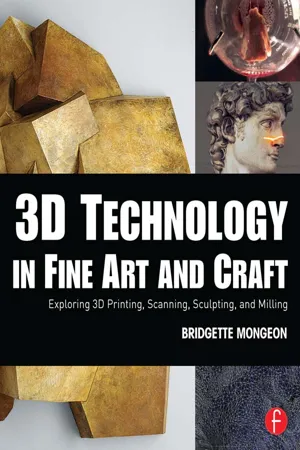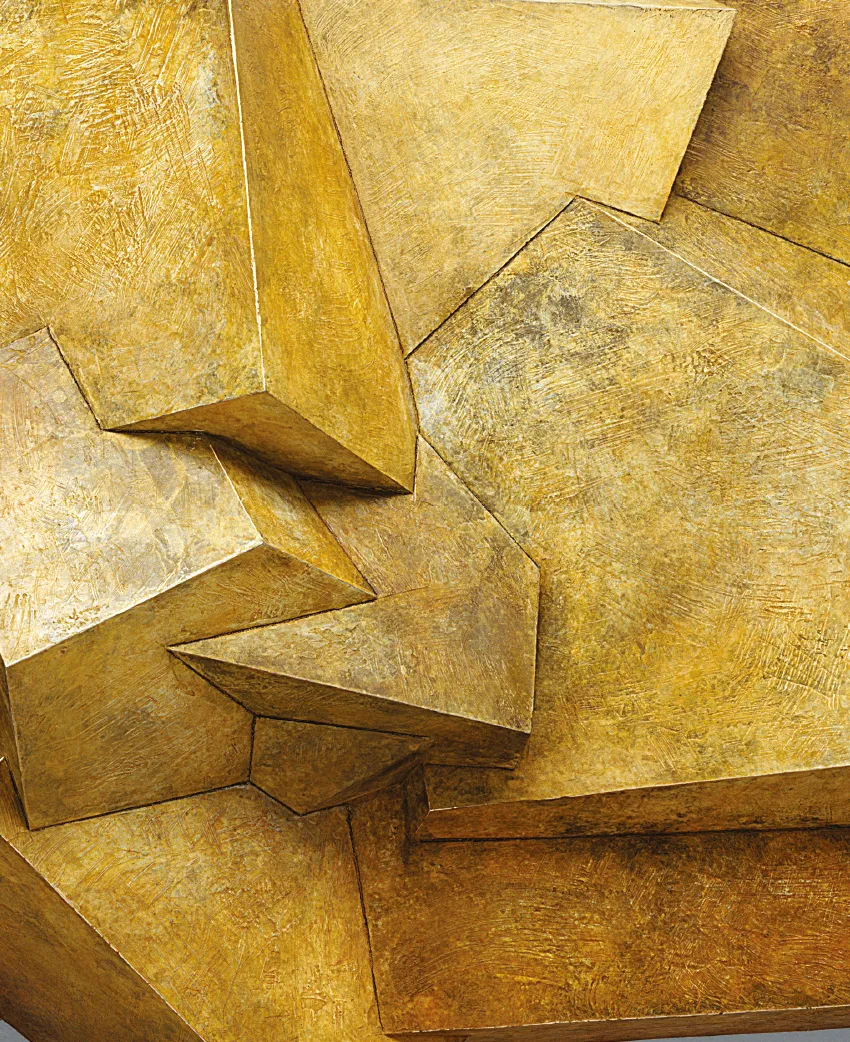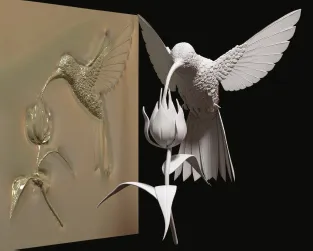CHAPTER ONE
PRIMER
___________
“It is like a composer sitting down with notes and chords to get a feel for where the music is going.”
Bruce Beasley discusses the freedom of creating fine art in a computer without any physical constraints
Custos II by Bruce Beasley. Photograph: Lee Fatheree
When a traditional artist enters into the world of 3D technology and they begin to listen in on a dialogue between seasoned 3D technicians and/or computer graphics (CG) artists, the conversation might begin to sound more like the wah-wah-wah of Charlie Brown’s teacher in the Peanuts cartoon. Those entering the world of technology and hearing such discussions can quickly become overwhelmed and feel that they need a translator or a crash course in computer graphics before they can continue. Relax and take a deep breath, this journey will be as painless as possible. We structured this book to give the reader inspiration in the world of 3D art and we break down the processes, steps, and technology. The resource section and the book’s accompanying website hold even more information, including links to videos that will help to get you up to speed. Take your time. Use this section of the book to become familiar with 3D technology. Refer back to this section when necessary. Meanwhile, enjoy the artists featured throughout the book. They all share their process, tools, and vendors, which takes the guesswork out of your creative exploration. You might even try some of the free options for software and other tools to get your feet wet. Once you proceed past the unknown and familiarize yourself with the tools, along with dabbling a little in the processes, you will find a world full of possibilities.
There are certain terms that relate to 3D technology that will be helpful for you to know as you travel on your journey of incorporating 3D technology into your traditional art and craft processes. If you are already working in computer graphics, then this chapter will be very elementary, and you can probably think of a dozen or two more things to add to it. However, this chapter is a very basic primer to assist those who are working with a traditional artistic background. It is here to help you begin to understand this new virtual world. To those traditional artists, this chapter may seem daunting. Don’t let it scare you away from the wonderful possibilities available to you. You don’t have to know everything here to get started. This book and your vendors, the service bureaus, and support team can assist you in creating some marvelous projects while becoming more familiar with the technology. As the technology grows and becomes more accessible to the general consumer, the learning curve will decline. The technology will even become easier. Vendors are providing a great deal of assistance. With many vendors, their technical support team takes care of the back end of the business of incorporating the art and technology. The vendors realize the importance of educating the public in this new technology, and many take the time to do so. Also, as you will see in other chapters, new businesses are positioning themselves as middlemen between artist and vendor. They understand that not everyone thinks in the same way. Some artists may not want to immerse themselves into the technology; they just want the technology to work for them. They can visualize the final product but don’t know how to get there, especially when they only have the experience to create in the traditional fine art sculpting world. Dependable individuals and companies that offer their service as a go-between for the artist and service bureaus, help to take the mystery and confusion out of the technology. However, if you plan on using the computer to create digitally, you will need to become more familiar with the digital world. You will also want to translate your ideas succinctly, and the most exciting part about this new technology, that you will see demonstrated over and over again in this book, is that if you know how it works, you can manipulate it, change it, and push it to do things that have never been done before. To do this, you will need to communicate in the language from this other world. This means learning the dialogue. Consider the digital processes as just another tool that you are trying to master. Now, let’s familiarize ourselves with some things that at first may seem confusing, but eventually will become clearer on your own creative journey of using 3D technology.
Open Source
Open source is a concept for development of software, hardware, and other items. It is a great concept and for many it means “free” software. When the public considers software open source it means that not only is the software free, but the code that runs the software is also made available. By making both the code and the software free, the software or product will evolve and improve through shared development. People from all over the world will be contributing to improving the product.
A user of open source software may think that because there is not one owner, there is no support. However, open source often brings a strong community of followers. The followers have a commitment; they feel invested as if they own a part of the product. The community wants it to grow and get better, to be the best that it can be. Usually documentation, forums, videos, and other tools for users are readily available. For example, the software Blender became open source in 2002. Artists use Blender for modeling, animation, and movies. In this book, we will refer often to another open source software called MeshLab. MeshLab began as a course assignment at the University of Pisa in 2005. Artists may use MeshLab to change files from one extension to the other, or reduce the polygon count. Extensions, polygons… don’t let these terms confuse you. These are covered further in this chapter.
You are probably getting excited thinking about the possibilities that are available to you, and that you can use these tools with no cost. Let’s look at a few more things in the digital world first.
Open source has grown from just free software and hardware. Open source is now considered more of a movement in technology. For example, in 2007 Adrian Bowyer and a team at the University of Bath created the RepRap (short for Replicating Rapid Prototyper) as an open source 3D printer design. Many of the parts that are available for the RepRap are actually made by a RepRap 3D printer. In other words, it reproduces itself. The hope of those that created the first RepRap 3D printer is that it will develop and grow as others work with it and modify the design.
The user community is involved in the advances of open source software. For example, Vilem Novak developed a Blender CAM add-on that can export the code needed for CNC milling.
There are many quality open source products that this book will refer to and that we will list on the accompanying website. What that means to the artist or craftsperson who might like to use these tools is that there may be little or no cost involved with obtaining and using them. Those artists or craftspeople that think that there will be a large investment into using technology in conjunction with their traditional methods of creating can put their minds to rest. Yes, you may need a computer, but investment into expensive equipment and software may not be necessary, due to the increased participation in the open source movement.
Hacker
The word “hacker” has had negative connotations. We all dread hearing “someone hacked into your system.” We picture dark basements with seedy characters trying to get into our checking accounts and draining our savings. We see hackers as the invisible Internet black-hat bandits versus the white-hat good guys.
But the word “hacker” has another meaning entirely. In another, more positive and adventurous, light the word “hacker” refers to a person who modifies software and hardware or other things to make them better. This “hacking” is at the root of how art and creativity help the technology evolve. The technology must change to suit the needs of the user. Creative people push the limits. In the case of art and technology, “hacking” is a term that can make things exciting. Hacking is solving problems creatively. It is what this book is about. For example, Solheim Additive Manufacturing Laboratory in the Mechanical Engineering Department at the University of Washington has pushed the limits of their 3D printing machines. In Chapter 4 we will see how they are using ceramics, glass, and other materials in their 3D printers. They share their progress in “hacking” as they push their machines and the technology. They encourage others to share their development of open source technology through their blog and through collaboration with other universities and individuals.
Jonathan Keep, Iceberg, www.keep-art.co.uk, self-build DIY delta ceramic 3D printer and Iceberg. Artist 3D-printed porcelain clay and glaze, 16 × 12 × 24 cm.
The combination of open source, hacker, and sharing is a progressive and creative endeavor. Ceramic artists at Unfold featured in the 3D Printing chapter share their process of ceramic 3D printing openly online. Artist Jonathan Keep was able to create his own work environment and experiments using 3D printing of ceramics because of the willingness of others to share in the open source community. Keep now shares his exploration in 3D printing from his website. For links to these websites and information on how Keep or Unfold built their 3D ceramic printers, visit this book’s accompanying website at www.digitalsculpting.net.
The educational initiative of STEAM featured in the appendix incorporates art with the former STEM educational initiative of science, technology, engineering, and math. In STEAM, the art element encourages us to be creative thinkers. Art helps us to look at things in a...



